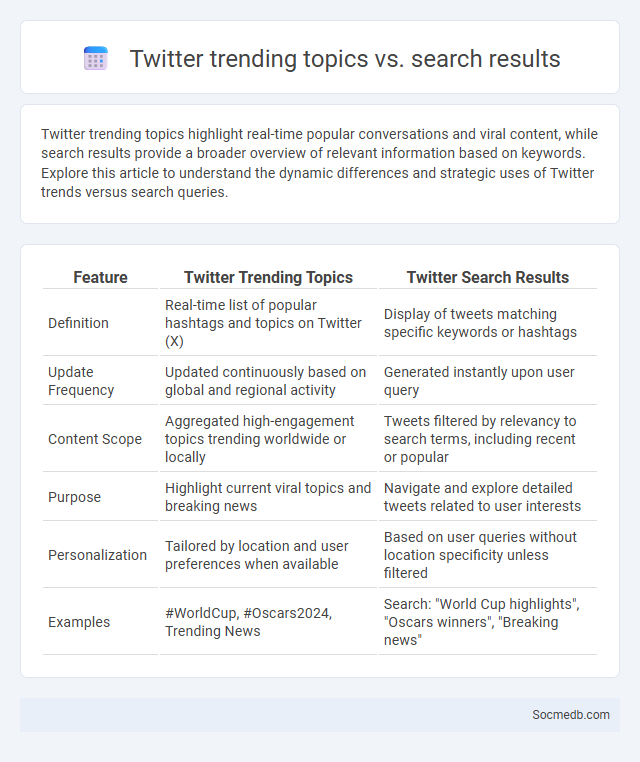
Photo illustration: Twitter trending topics vs search results
Twitter trending topics highlight real-time popular conversations and viral content, while search results provide a broader overview of relevant information based on keywords. Explore this article to understand the dynamic differences and strategic uses of Twitter trends versus search queries.
Table of Comparison
| Feature | Twitter Trending Topics | Twitter Search Results |
|---|---|---|
| Definition | Real-time list of popular hashtags and topics on Twitter (X) | Display of tweets matching specific keywords or hashtags |
| Update Frequency | Updated continuously based on global and regional activity | Generated instantly upon user query |
| Content Scope | Aggregated high-engagement topics trending worldwide or locally | Tweets filtered by relevancy to search terms, including recent or popular |
| Purpose | Highlight current viral topics and breaking news | Navigate and explore detailed tweets related to user interests |
| Personalization | Tailored by location and user preferences when available | Based on user queries without location specificity unless filtered |
| Examples | #WorldCup, #Oscars2024, Trending News | Search: "World Cup highlights", "Oscars winners", "Breaking news" |
Understanding Twitter Trending Topics
Twitter trending topics reveal real-time discussions by highlighting hashtags and keywords gaining rapid popularity among users worldwide. These trends are influenced by factors such as tweet volume, user engagement, retweets, and geographic location, providing insights into public interests and current events. Analyzing trending topics helps businesses, marketers, and researchers track shifting consumer behavior and emerging social issues on the platform.
How Twitter’s Search Results Work
Twitter's search results are generated through an algorithm that prioritizes relevance, recency, and engagement, displaying tweets that best match the user's query. The search engine indexes tweets, user profiles, hashtags, and trending topics, leveraging natural language processing to understand intent and context. Tweets with higher likes, retweets, and replies are favored, ensuring the most popular and timely content appears at the top of search results.
The Basics of Twitter’s Trending Algorithm
Twitter's trending algorithm identifies popular topics by analyzing real-time tweet volume, user engagement, and geographic data. It prioritizes fresh, rapidly growing discussions rather than long-standing popular subjects, ensuring relevance and immediacy. This dynamic system uses machine learning to filter spam and personalize trends based on individual user interests and location.
Key Differences: Trending Topics vs Search Results
Trending topics on social media represent real-time, popular conversations driven by user engagement and viral content, often reflecting current events and cultural moments. Search results, however, are generated based on user queries, delivering tailored content ranked by relevance, keywords, and algorithmic factors rather than popularity alone. Understanding these distinctions helps marketers optimize content strategies by targeting either viral trends or specific user intent within social platforms.
Factors Influencing Twitter Trends
Twitter trends are primarily influenced by user engagement metrics such as retweets, likes, and mentions, which signal content relevance and popularity. Algorithmic factors including real-time event detection, geographic location, and topical clusters also play a crucial role in determining trending topics. External triggers like breaking news, celebrity activity, and viral campaigns significantly impact trend emergence and duration.
How the Trending Algorithm Curates Content
The trending algorithm on social media platforms curates content by analyzing user interactions such as likes, shares, comments, and viewing time to identify popular and relevant posts. Machine learning models continuously assess real-time data and engagement patterns to prioritize content that sparks high user interest within specific communities or globally. This dynamic system ensures personalized feeds, promoting viral trends while adapting to shifting user behaviors and preferences.
User Engagement’s Role in Trends and Search
User engagement drives social media trends by amplifying content visibility through likes, shares, and comments, making it easier for users to discover popular topics. Algorithms prioritize highly engaged posts, enhancing their reach and influencing search rankings within platforms. Your active participation boosts the relevance of trends, shaping what content receives attention and gains momentum online.
Manipulation and Authenticity in Trending Topics
Social media platforms often amplify manipulation through algorithms that prioritize sensational or misleading content, impacting the authenticity of trending topics. You can easily encounter curated narratives designed to influence opinions and behaviors, undermining genuine discourse. Ensuring critical evaluation of trending subjects helps safeguard your awareness and promotes authentic engagement online.
Regional and Personalization Effects on Twitter Trends
Regional and personalization effects heavily influence Twitter trends, as localized content and user behavior shape what topics gain popularity. Twitter's algorithm tailors feeds based on geographic location, language preferences, and interaction history, ensuring that Your timeline reflects relevant, region-specific discussions. This dynamic personalization enhances engagement by connecting users with trends that resonate within their community and personal interests.
Optimizing Content for Twitter Trends and Search
Optimizing your content for Twitter trends and search requires using relevant keywords, trending hashtags, and engaging visuals that resonate with your target audience. Craft concise, impactful tweets that encourage interaction and leverage Twitter's real-time analytics to adjust your strategy instantly. Boost Your visibility by timing posts around peak user activity and participating in popular conversations to enhance discoverability.
 socmedb.com
socmedb.com